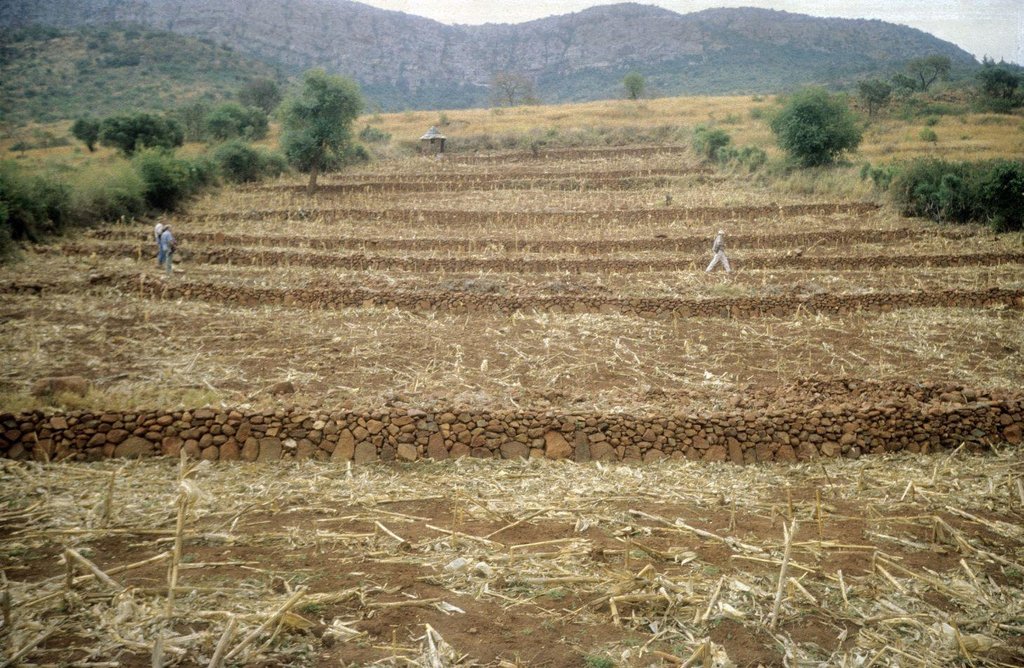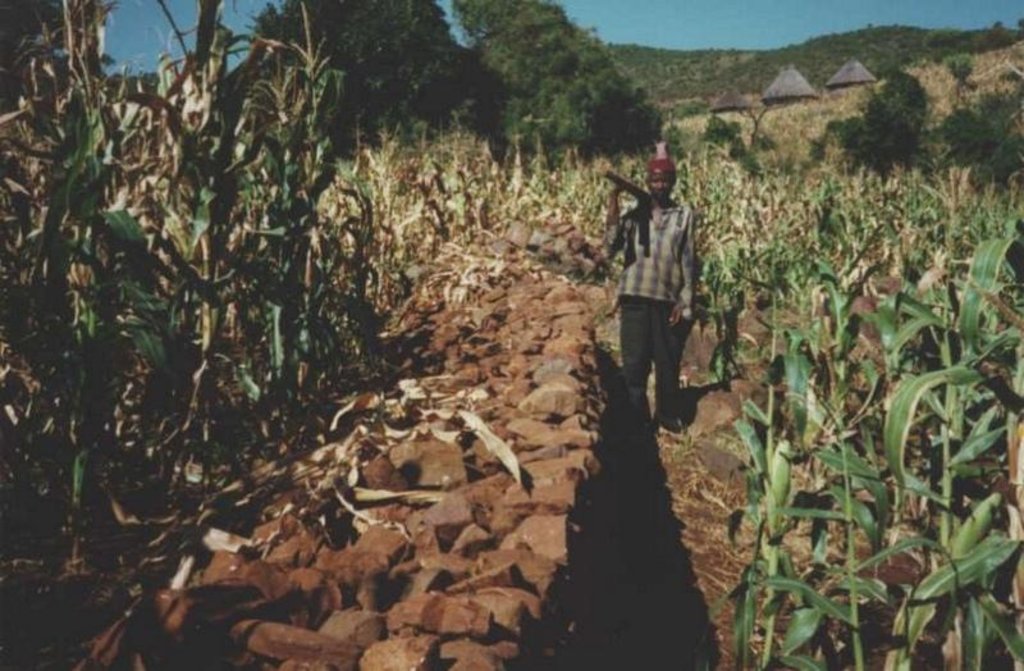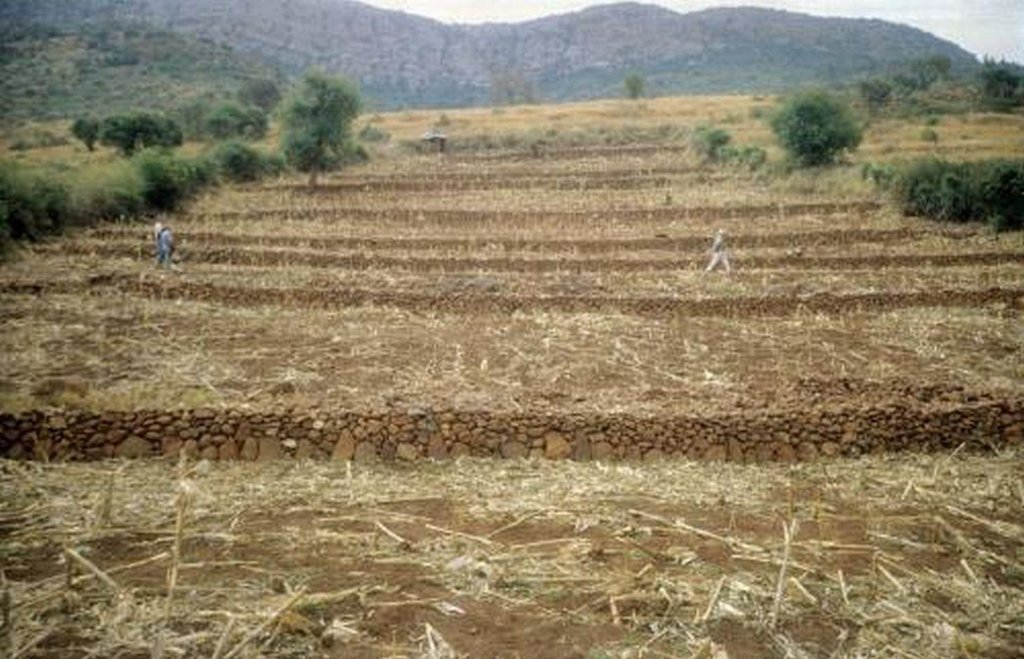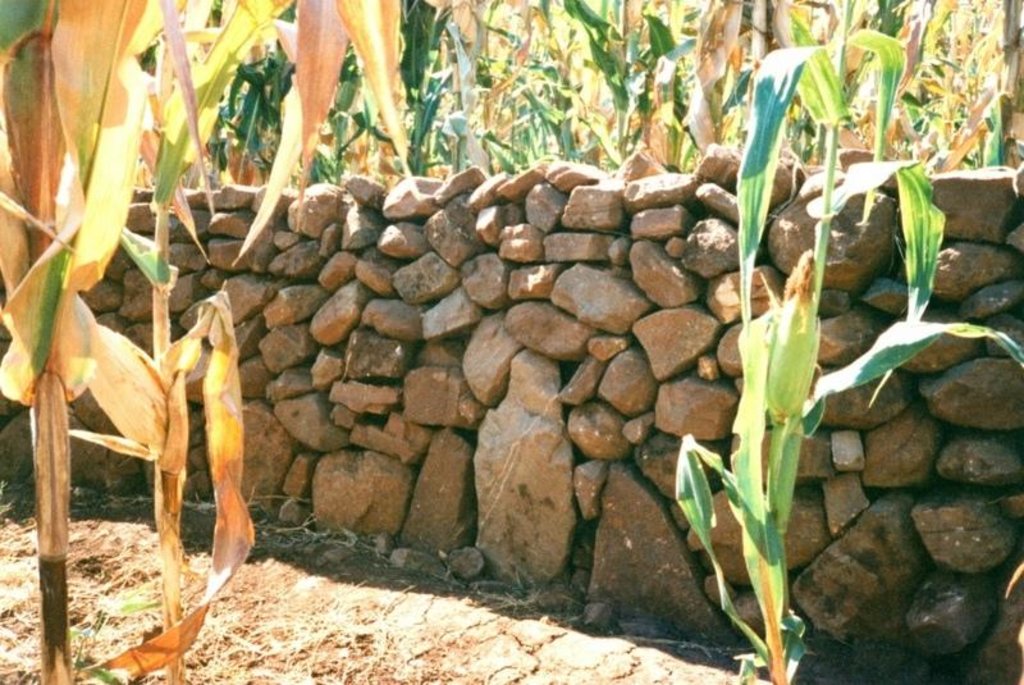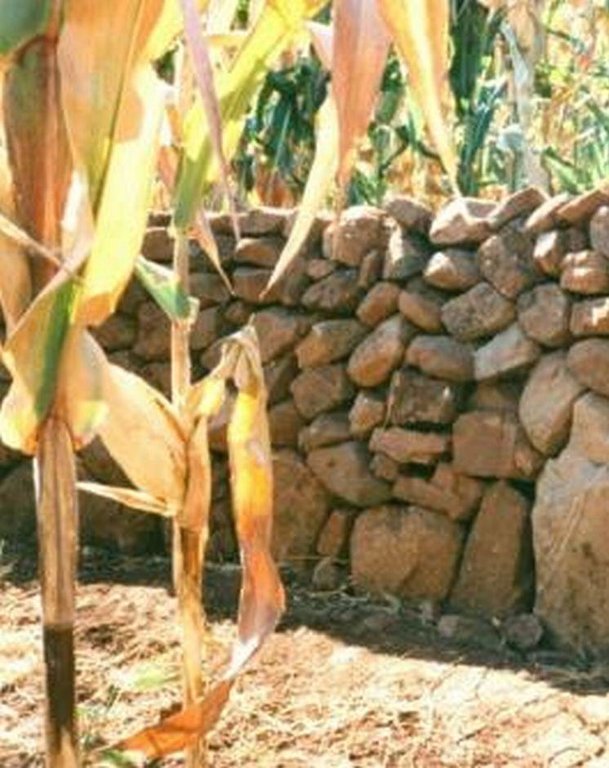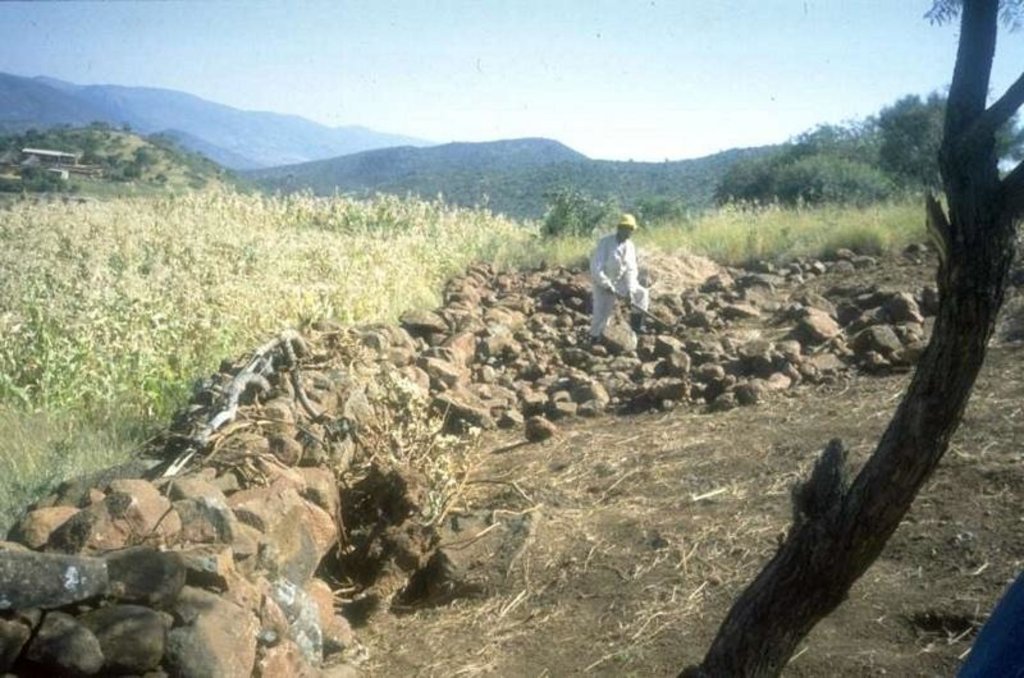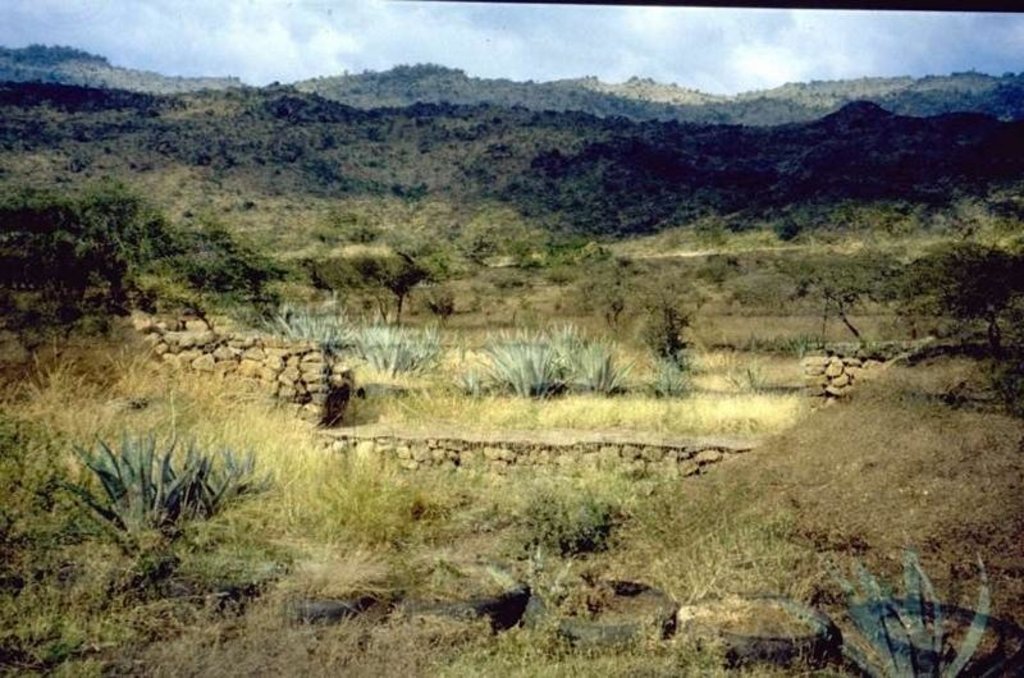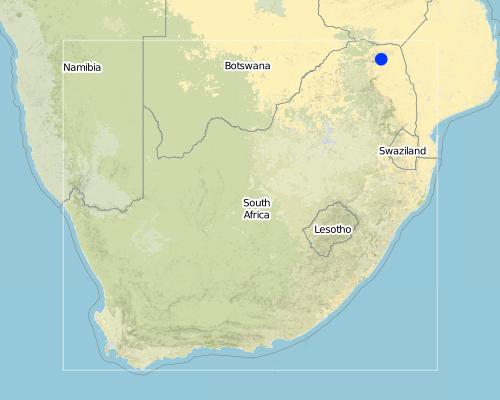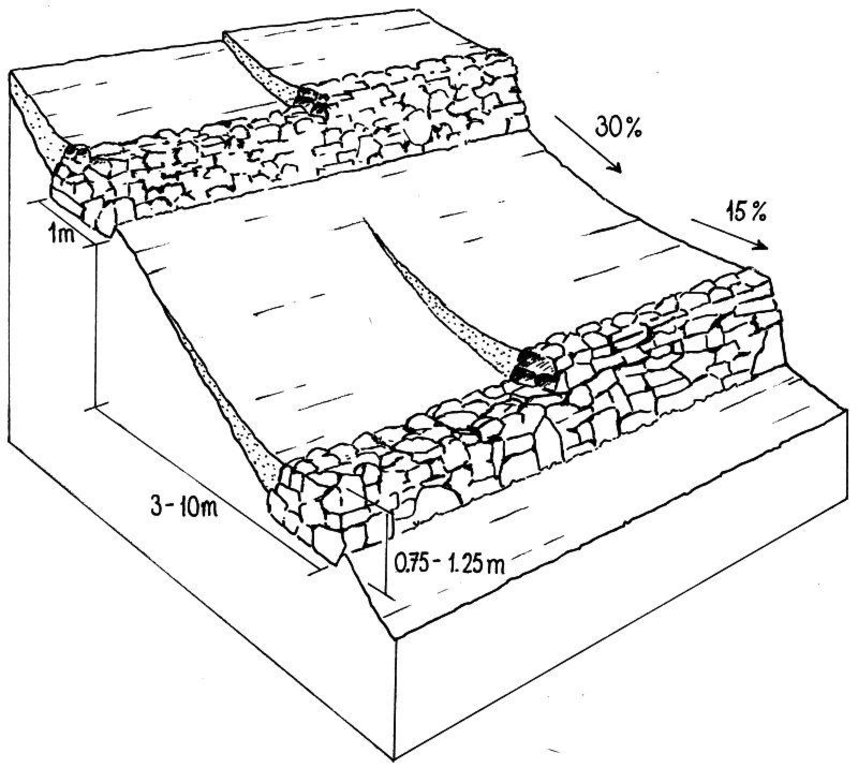Traditional stone wall terraces [南非]
- 创建:
- 更新:
- 编制者: William Critchley
- 编辑者: –
- 审查者: David Streiff
Mitsheto (Venda language)
technologies_1369 - 南非
查看章节
全部展开 全部收起1. 一般信息
1.2 参与该技术评估和文件编制的资源人员和机构的联系方式
有助于对技术进行记录/评估的机构名称(如相关)
CIS-Centre for International Cooperation (CIS-Centre for International Cooperation) - 荷兰1.3 关于使用通过WOCAT记录的数据的条件
(现场)数据是什么时候汇编的?:
16/08/1997
编制者和关键资源人员接受有关使用通过WOCAT记录数据的条件。:
是
2. SLM技术的说明
2.1 技术简介
技术定义:
Stone walls built on sloping fields to create terraces for cultivation and conservation: both ancient and contemporary.
2.2 技术的详细说明
说明:
In this hilly, mixed farming area, stone terrace walls are a tradition. They are built across the slope when new land is cleared of loose stone and brought into crop cultivation. The dimensions of the terrace walls and the spacing between them depend on various factors, especially the slope and the amount of stone in the field. The walls may be up to 1.25 m high, from 1.0 to 1.5 m in base width, and between 20 and 50 m long. Spacing is from 3 to 10 m apart. Design of stone terrace walls varies. Some walls are very neatly built, others are merely piles of stone across the slope: this depends on the individual land user. The walls are built up each year with further stones: this may just be as more loose stone comes to the surface when ploughing, or also by digging out larger stones to deliberately build up the height of the walls as it silts up behind. Such terracing is generally confined to slopes between 20% and 50%. From 12% to 20% contour grass strips (thambaladza) are normally used, but below 12% land is rarely protected with structures or strips.
Purpose of the Technology: The purpose of terracing, apart from simultaneously clearing the land of stone, is to guard against loss of topsoil. Together with contour ploughing this helps to keep soil fertility in place on sloping cropland in a subhumid area. Rainfall is around 1,000 mm per annum and maize is the most common crop, but various other annuals (beans, pumpkins, sorghum etc) and perennials (peaches, avocadoes, oranges etc) are also grown.
Natural / human environment: This example of land conservation is probably unique in a former South African ‘homeland’. In such areas, where the black population were concentrated at high population densities under the former apartheid regime, land degradation rather than soil conservation was the rule. These terraces continue to be built to this day as new land is opened up, despite the high amounts of labour (300-500 person days per hectare) involved in establishment. A study of the conservation systems used in the area and local attitudes to them, showed that the benefits of conservation were well understood by local farmers (see reference). Those questioned identified retention of soil - and of soil fertility in particular - as being of paramount importance. No mention was made of terraces being built simply to remove surface stone. The only downside mentioned (by a few) was the loss of cultivable land area. The key to the persistence of the terraces in this area is, therefore, that the land users understand and appreciate the place of terraces in maintaining soil fertility, and their considerable contribution to crop production.
2.3 技术照片
2.5 已应用该技术的、本评估所涵盖的国家/地区/地点
国家:
南非
区域/州/省:
Limpopo Province
有关地点的进一步说明:
Thononda Ward (Thohoyandou district)
Map
×2.6 实施日期
如果不知道确切的年份,请说明大概的日期:
- 50多年前(传统)
2.7 技术介绍
详细说明该技术是如何引入的:
- 作为传统系统的一部分(> 50 年)
注释(项目类型等):
May have originated with the Shona of Zimbabwe and the tradition brought with them when some moved south to Venda
3. SLM技术的分类
3.1 该技术的主要目的
- 减少、预防、恢复土地退化
3.2 应用该技术的当前土地利用类型

农田
- 一年一作
- 乔木与灌木的种植
主要农作物(经济作物及粮食作物):
major cash crop: Maize and avocado
major food crop: Maize
注释:
Major land use problems (compiler’s opinion): Agreement with the land-user
Major land use problems (land users’ perception): Decline in fertility of soil, erosion on roads/from roads, yield burning leading to runoff.
3.3 有关土地利用的更多信息
该技术所应用土地的供水:
- 雨养
每年的生长季节数:
- 1
具体说明:
Longest growing period in days: 150; Longest growing period from month to month: Nov - May
3.4 该技术所属的SLM组
- 横坡措施
3.5 技术传播
具体说明该技术的分布:
- 均匀地分布在一个区域
如果该技术均匀地分布在一个区域上,请注明覆盖的大致区域。:
- 1-10 平方千米
注释:
Total area covered by the SLM Technology is 8 km2.
Within the Northern region of South Africa's Northern Province (formerly "Venda") a few areas are apparently covered with ancient stone terraces - but Thononda Ward of Thohoyandou district is the best example and the only one
3.6 包含该技术的可持续土地管理措施

农艺措施

结构措施
- S1:阶地
注释:
Main measures: structural measures
Secondary measures: agronomic measures
3.7 该技术强调的主要土地退化类型

土壤水蚀
- Wt:表土流失/地表侵蚀

化学性土壤退化
- Cn:肥力下降和有机质含量下降(非侵蚀所致)
注释:
Main causes of degradation: Heavy / extreme rainfall (intensity/amounts) (slope), other natural causes (avalanches, volcanic eruptions, mud flows, highly susceptible natural resources, extreme topography, etc.) specify (Slope/rainfall)
Secondary causes of degradation: other human induced causes (specify) (Burning of veld/grazing land upslope)
3.8 防止、减少或恢复土地退化
具体数量名该技术与土地退化有关的目标:
- 防止土地退化
4. 技术规范、实施活动、投入和成本
4.1 该技术的技术图纸
4.2 技术规范/技术图纸说明
Layout of stone wall terraces: the walls are built up over time (right) as soil accumulates behind the barriers.
Date: Northern Province
Technical knowledge required for land users: moderate
Main technical functions: control of dispersed runoff: impede / retard
Secondary technical functions: reduction of slope angle, reduction of slope length
Structural measure: Bunds/banks: contour
Vertical interval between structures (m): varied
Spacing between structures (m): 3 -10
Height of bunds/banks/others (m): > 0.75
Width of bunds/banks/others (m): > 1.5
Length of bunds/banks/others (m): 20 -50
Construction material (stone): From within fields only
Slope (which determines the spacing indicated above): 30%
If the original slope has changed as a result of the Technology, the slope today is: 15%
4.3 有关投入和成本计算的一般信息
具体说明成本和投入是如何计算的:
- 每个技术单元
指定单位:
ha
具体说明成本计算所用货币:
- 美元
注明雇用劳工的每日平均工资成本:
3.50
4.4 技术建立活动
| 活动 | 措施类型 | 时间 | |
|---|---|---|---|
| 1. | Initial construction of terrace walls (Layout is by eye: no instruments used) | 结构性的 | Dry season |
| 2. | Construction of new stone walls begins with a shallow trench into which large foundation stones are laid (or rolled downhill with a ‘crowbar’ – a long steel lever - if very big). | 结构性的 | |
| 3. | Terrace walls are then built up with successively smaller stones: design depends on the individual. | 结构性的 | |
| 4. | Stiles (low points) are generally left in the walls to allow human passage, but these are ‘staggered’ (ie not all in a straight line up-and-down slope) to avoid gullies forming. | 结构性的 |
4.5 技术建立所需要的费用和投入
| 对投入进行具体说明 | 单位 | 数量 | 单位成本 | 每项投入的总成本 | 土地使用者承担的成本% | |
|---|---|---|---|---|---|---|
| 劳动力 | Construction of stone walls and terraces | persons/day/ha | 357.0 | 3.5 | 1249.5 | 100.0 |
| 设备 | Tools | ha | 1.0 | 20.0 | 20.0 | 100.0 |
| 技术建立所需总成本 | 1269.5 | |||||
注释:
Duration of establishment phase: 12 month(s)
4.6 维护/经常性活动
| 活动 | 措施类型 | 时间/频率 | |
|---|---|---|---|
| 1. | The walls are increased in height each year as it silts up behind. | 结构性的 | Dry season (winter)/Annual |
4.7 维护/经常性活动所需要的费用和投入(每年)
| 对投入进行具体说明 | 单位 | 数量 | 单位成本 | 每项投入的总成本 | 土地使用者承担的成本% | |
|---|---|---|---|---|---|---|
| 劳动力 | Increase hight | persons/day/ha | 46.0 | 3.5 | 161.0 | 100.0 |
| 技术维护所需总成本 | 161.0 | |||||
注释:
A 100 m x 100 m field with a slope of about 20 degrees (35%) with bund of 0,75 sqm cross section initially at 10 m horizontal intervals assuming 2 sqm moved per- person-day
4.8 影响成本的最重要因素
描述影响成本的最决定性因素:
Slope and amount of loose stones available (the more loose stones the more has to been moved to make cultivation possible)
5. 自然和人文环境
5.1 气候
年降雨量
- < 250毫米
- 251-500毫米
- 501-750毫米
- 751-1,000毫米
- 1,001-1,500毫米
- 1,501-2,000毫米
- 2,001-3,000毫米
- 3,001-4,000毫米
- > 4,000毫米
农业气候带
- 半湿润
5.2 地形
平均坡度:
- 水平(0-2%)
- 缓降(3-5%)
- 平缓(6-10%)
- 滚坡(11-15%)
- 崎岖(16-30%)
- 陡峭(31-60%)
- 非常陡峭(>60%)
地形:
- 高原/平原
- 山脊
- 山坡
- 山地斜坡
- 麓坡
- 谷底
垂直分布带:
- 0-100 m a.s.l.
- 101-500 m a.s.l.
- 501-1,000 m a.s.l.
- 1,001-1,500 m a.s.l.
- 1,501-2,000 m a.s.l.
- 2,001-2,500 m a.s.l.
- 2,501-3,000 m a.s.l.
- 3,001-4,000 m a.s.l.
- > 4,000 m a.s.l.
关于地形的注释和进一步规范:
Altitudinal zone: 800 - 1200
5.3 土壤
平均土层深度:
- 非常浅(0-20厘米)
- 浅(21-50厘米)
- 中等深度(51-80厘米)
- 深(81-120厘米)
- 非常深(> 120厘米)
土壤质地(表土):
- 中粒(壤土、粉土)
表土有机质:
- 中(1-3%)
如有可能,附上完整的土壤描述或具体说明可用的信息,例如土壤类型、土壤酸碱度、阳离子交换能力、氮、盐度等。:
Soil texture: Mainly loans in cultivated areas
Soil fertility is medium
Soil drainage / infiltration is good
Soil water storage capacity is medium - high
5.6 应用该技术的土地使用者的特征
生产系统的市场定位:
- 生计(自给)
- 混合(生计/商业
机械化水平:
- 手工作业
- 畜力牵引
说明土地使用者的其他有关特征:
Level of mechanization: Also mechnanized.
5.7 应用该技术的土地使用者拥有或租用的平均土地面积
- < 0.5 公顷
- 0.5-1 公顷
- 1-2 公顷
- 2-5公顷
- 5-15公顷
- 15-50公顷
- 50-100公顷
- 100-500公顷
- 500-1,000公顷
- 1,000-10,000公顷
- > 10,000公顷
注释:
Average area of land owned or leased by land users applying the Technology: Also 2-5 ha
5.8 土地所有权、土地使用权和水使用权
土地所有权:
- 个人,未命名
土地使用权:
- 自由进入(无组织)
- 个人
6. 影响和结论性说明
6.1 该技术的现场影响
社会经济效应
生产
作物生产
注释/具体说明:
Estimates
收入和成本
农业收入
注释/具体说明:
Estimates
工作量
社会文化影响
社区机构
SLM/土地退化知识
注释/具体说明:
Estimates
生态影响
土壤
土壤水分
注释/具体说明:
Estimates
土壤流失
注释/具体说明:
Estimates
6.2 该技术的场外影响已经显现
旱季稳定可靠的水流
下游洪水
下游淤积
地下水/河流污染
6.4 成本效益分析
技术收益与技术建立成本相比如何(从土地使用者的角度看)?
短期回报:
非常消极
长期回报:
积极
技术收益与技术维护成本/经常性成本相比如何(从土地使用者的角度看)?
短期回报:
稍微积极
长期回报:
稍微积极
6.5 技术采用
- 单例/实验
如若可行,进行量化(住户数量和/或覆盖面积):
1 household
在所有采用这项技术的人当中,有多少人是自发地采用该技术,即未获得任何物质奖励/付款?:
- 90-100%
注释:
1% of land user families have adopted the Technology with external material support
1 land user families have adopted the Technology with external material support
Comments on acceptance with external material support: survey results
100% of land user families have adopted the Technology without any external material support
Comments on spontaneous adoption: estimates
There is a moderate trend towards spontaneous adoption of the Technology
Comments on adoption trend: As land becomes more limited for cultivation, people are forced to cultivate steeper and stonier land. This is a "living" tradition!
6.7 该技术的优点/长处/机会
| 土地使用者眼中的长处/优势/机会 |
|---|
| Maintains soil and soil fertility |
| Stops crops being washed away |
| Reduces spread of weed species |
| Maintains ploughability |
| 编制者或其他关键资源人员认为的长处/优势/机会 |
|---|
|
This is an important example of a thriving traditional technology in a country where most such ancient practices were ended by apartheid How can they be sustained / enhanced? It has the potential to persist, if the Department of Agriculture acknowledges the importance of the system, encourages and gives training and organises exchange visits between farmers. Exchange of knowledge from farmer to farmer is facilitated by ‘Landcare’ and supported by the government. |
| It makes use of abundant existing materials in the field (stone) and therefore input costs apart from labour are low: this is a win-win situation, clearing and building. |
| Maintenance is simple – merely building up the walls gradually – and is effectively absorbed in everyday farming activities. |
6.8 技术的弱点/缺点/风险及其克服方法
| 土地使用者认为的弱点/缺点/风险 | 如何克服它们? |
|---|---|
| Labour cost | |
| Land lost (but equally gained by removal of surface stone) |
| 编制者或其他关键资源人员认为的弱点/缺点/风险 | 如何克服它们? |
|---|---|
| High labour investment for establishment | Hand tools, for example pickaxes and crowbars, could be supplied to the poorest families. |
7. 参考和链接
7.2 参考可用出版物
标题、作者、年份、ISBN:
Case study of Vhavenda, perception of erosion.... June 97.
可以从哪里获得?成本如何?
Paper submitted to "Development South Africa"
链接和模块
全部展开 全部收起链接
无链接
模块
无模块



